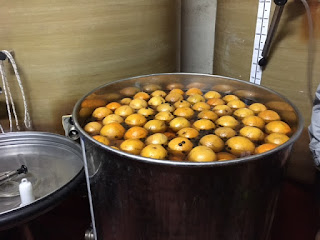Wednesday, July 12
La Haye du Puits, France
Today, we cycled in a light drizzle through the Norman countryside on a 24-mile round trip (14 miles for me).
More...
We passed lots of pastureland with grazing dairy cows (much bigger than our American breeds), and also several half-timbered country manor houses. Many of these manors were “borrowed” by German generals who used them as their headquarters during the Battle of Normandy.
After the D-Day landings and the liberation of several of the surrounding towns and villages, American troops headed south, to the town of La Haye du Puits. The Germans were waiting here, and a fierce week-long battle ensued. It was particularly difficult because this is hedgerow country, with lines of closely spaced shrubs and trees that are trained to form natural boundary lines. They’re very pretty, but they also made good hiding places for German snipers.
At La Haye du Puits, we stopped to view the monument and stones commemorating the sacrifices of the American 79th Division, the 82nd Airborne, and the 90th Division in their struggle to liberate the town. The town was badly damaged but was rebuilt in concrete. The parish church, however, lost one of its spires in the fighting, which has never been replaced.
We also explored the town’s fantastic Wednesday market, where a variety of local vendors bring their fruits, vegetables, and wares to sell.
After everyone had viewed the market, I got a lift in the van with Sophie over the hardest hills, then she dropped me off to meet up with Gary at an old church. Then we cycled to the cider farm where we were going to have lunch -- in a downpour. (Gary says the rain was his fault -- he jinxed us by taking off his jacket, then saying “Watch, it will probably start pouring now.” Which it did.)
At the farm, we had a picnic lunch, toured the premises to see how they make cider, and tasted the goods. Cider is very big in this region. They make an apple brandy called Calvados from the famous Normandy apples, which is made much like whiskey except they distill cider. This particular cider farm also makes a special type of Calvados called “44”, which is Calvados mixed with 44 oranges punctured with 44 holes; 44 coffee beans; 44 sugar cubes; and 44 vanilla beans. The mixture is then aged for 44 days and bottled. We liked it so much we bought a large bottle for €25.
The rest of the group then cycled on to the small town of Lessay to view its abbey built in 1056 (bombed in 1944 by the Germans before they retreated from the town). I rode back to the hotel in the van with Sophie.
Later on, we walked into the little village of St. Germain-sur-Ay with John and Yvonne and stopped at a local pub called Chez Marie for a drink. The village is so small that there are not really any restaurants big enough to accommodate all of us, so we had dinner back at the hotel.
Sunday, August 13, 2017
Subscribe to:
Post Comments (Atom)










No comments:
Post a Comment